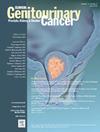Efficacy of Neoadjuvant Hormonal Therapy for High-Risk Prostate Cancer Undergoing Robot-Assisted Radical Prostatectomy: A Retrospective Multicenter Study Using Propensity Score-Matched Analysis in Japan
IF 2.7
3区 医学
Q3 ONCOLOGY
引用次数: 0
Abstract
Introduction
The potential improvement in oncological outcomes of robot-assisted radical prostatectomy (RARP) with neoadjuvant androgen deprivation therapy (ADT) in patients with prostate cancer (PCa) who had high-risk or very-high risk disease (HR/VHR-PCa) remains controversial. This study evaluated the impact of neoadjuvant hormone therapy (NHT) on biochemical recurrence (BCR) following RARP.
Materials and Methods
A total of 1,203 patients with HR/VHR-PCa who underwent RARP at 6 centers in Japan were included. Patients were categorized into 2 groups: those who underwent RARP alone (RARP-alone group) and those who underwent RARP following NHT (NHT group). The primary endpoint was biochemical recurrence-free survival (BRFS) after RARP.
Results
A total of 976 patients were analyzed, including 140 patients in each group after propensity score matching. At a median follow-up of 47 months, BCR was observed in 40.7% of patients in the RARP-alone group and 31.4% in the NHT group (P = .106). BRFS rates did not significantly differ between the 2 groups (P = .671). The RARP-alone group tended to have slightly longer operative times and more positive surgical margins than the NHT group.
Conclusion
This study suggests that NHT does not improve BRFS in patients with HR/VHR-PCa undergoing RARP. Further research is necessary to develop more effective neoadjuvant regimens for this patient population.
新辅助激素治疗对接受机器人辅助根治性前列腺切除术的高危前列腺癌的疗效:日本一项使用倾向评分匹配分析的回顾性多中心研究
机器人辅助根治性前列腺切除术(RARP)联合新辅助雄激素剥夺治疗(ADT)对高风险或极高风险前列腺癌(HR/VHR-PCa)患者的肿瘤预后的潜在改善仍存在争议。本研究评估了新辅助激素治疗(NHT)对RARP术后生化复发(BCR)的影响。材料与方法本研究共纳入1,203例在日本6个中心接受RARP治疗的HR/VHR-PCa患者。将患者分为单纯RARP组(RARP组)和NHT后RARP组(NHT组)。主要终点是RARP后的生化无复发生存期(BRFS)。结果共分析976例患者,经倾向评分匹配后,每组140例。在中位随访47个月时,单独rarp组和NHT组分别有40.7%和31.4%的患者出现BCR (P = 0.106)。两组间BRFS率无显著差异(P = 0.671)。与NHT组相比,rarp组的手术时间稍长,阳性切缘较多。结论本研究提示NHT不能改善HR/VHR-PCa行RARP患者的BRFS。为这一患者群体开发更有效的新辅助方案需要进一步的研究。
本文章由计算机程序翻译,如有差异,请以英文原文为准。
求助全文
约1分钟内获得全文
求助全文
来源期刊

Clinical genitourinary cancer
医学-泌尿学与肾脏学
CiteScore
5.20
自引率
6.20%
发文量
201
审稿时长
54 days
期刊介绍:
Clinical Genitourinary Cancer is a peer-reviewed journal that publishes original articles describing various aspects of clinical and translational research in genitourinary cancers. Clinical Genitourinary Cancer is devoted to articles on detection, diagnosis, prevention, and treatment of genitourinary cancers. The main emphasis is on recent scientific developments in all areas related to genitourinary malignancies. Specific areas of interest include clinical research and mechanistic approaches; drug sensitivity and resistance; gene and antisense therapy; pathology, markers, and prognostic indicators; chemoprevention strategies; multimodality therapy; and integration of various approaches.
 求助内容:
求助内容: 应助结果提醒方式:
应助结果提醒方式:


